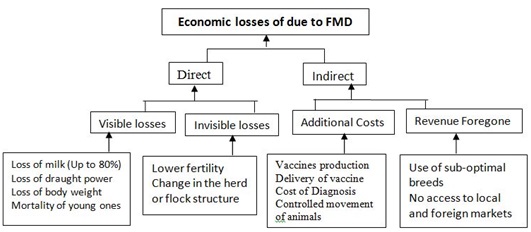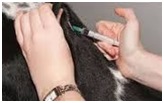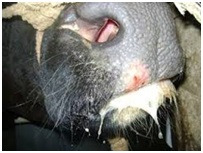Introduction: Foot and Mouth Disease or FMD is a one of the most contagious viral disease of cloven-hoofed (cattle, pigs, sheep) species. Cattle are most susceptible to it. This is characterized by fever and vesicles in mouth, muzzle, between the hooves andteat. In a susceptible non-vaccinated population, could be as high as 100%. It is rarely fatal in adult animals but high mortality in young animals due to myocarditis or lack of milk when the dam is infected by the disease. The disease causes severe production losses. The affected animal becomes weakened and debilitated.FMD has been listed by the World Organization for Animal Health (OIE) as the first disease for which a list of countries and zones with or without vaccination is available.
Etiology:
FMD virus is an aphthovirus of the family Picornaviridae. There areseven strains (A, O, C, SAT1, SAT2, SAT3, Asia1). Each serotype of FMD is distinct in antigens from other six serotypes. Each serotype requires a specific vaccinestrain to provide immunity to the vaccinated animal.In India the disease is caused by serotype O, A and Asia-1, of which serotype O is responsible for most of the outbreaks. Type O strain is the most important for disease spread into new areas.The FMD viral genome consists of a single strand of positive sense RNA of approximately 8,000 nucleotide bases.FMD virus can survive for long period of time in dark, moist conditions but is rapidly inactivated by a combination of desiccation, pH and temperature.
Epidemiology and Distribution
The epidemiology of FMD is affected by different host, environmental factors and virulence ofvirus (severity of lesions, amount and duration of virus release), particles stability in different microenvironments and chance of long term persistence.FMD virus multiplication and spread depend on the host species, nutritional and immunological status, population density, animal movements and contacts between different domestic and wild host species and animal capable of mechanical dissemination of the virus.
FMD is endemic in several parts of Asia, most of Africa and the Middle East. FMD viruses were found to be highest in China (pigs), India (cattle), the Near East (small ruminants) and the Sahel (small ruminants and cattle). In Latin America, the majority of countries free of FMD with or without vaccination and the disease remain endemic in only a few countries. Australia, New Zealand and Indonesia, Central and North America and continental Western Europe are currently free of FMD. However, FMD can occur sporadically in typically free areas.
Transmission
FMD is a highly transmissible disease and limited number of infective particles can initiate host infection. Contaminated animal products, non susceptible animals, agriculture tools, people, vehicles and airborne transmission can contribute to the mechanical dissemination of FMD virus.
FMD is viral disease that spread rapidly between animals. Virus is excreted in breath, saliva, mucus, milk and faeces. The virus can be excreted by animals within four days before clinical signs appear. Animals can become infected through inhalation, ingestion and direct contact. The disease spreads most commonly through the movement of infected animals. Transmission of FMD is generally by contact between susceptible and infected animals. Infected animals have a large amount of aerosolized virus in their exhaled air, which can infect other animal via the respiratory and oral routes. FMD has been transmitted to calves via infected milk tankers and contaminated fodder (through infected animals).
Pigs are regarded as ‘amplifying hosts’ because they can excrete very large quantities of virus in their exhaled breath. Cattle are indicator host of FMD and are able to infect by breathing in small quantities of the virus. Cattle, pig and sheep are regarded as carriers because virus can be continue to be carried for long periods (months or years) after apparent recovery. Sheep is the maintenance host of FMD, symptoms can be absent or very mild and undetected in infected sheep and it is important sources of infection.
Pathogenesis and Lesions:
After the entry of virus throughinhalation,primarily viral replication occurs in pharynx or respiratory tract after that infection reach to the blood stream, the virus is widely disseminated throughout the body, chiefly in mononuclear cells (epithelial tissue) and produces lesion.
In cattle the distribution of vesicular lesion occurs on the oral mucosa over the lips, dorsum of the tongue and palate. Lesion occurs in the skin of coronary band adjacent of inter digital space. They are also found on the lightly haired areas like vulva, teats and udder. In early stages of infection lesions are microscopic and are limited to the epithelium at the site of predilection. Lesions in the myocardium are most common in the fatal disease in young calves or lambs, but also occur in pig and young goats. Striped myocardium appear due to the lesion occur in cardiac wall, this type of heart is called tiger heart.
Clinical signs:
The clinical signs are directly related to the lesion. The main sign shown by the affected cattle include:
- Fever (103-1060F)
- Sudden and severe fall in milk yield
- Blisters form on: mouth, tongue, dental pad, gums, soft palate, muzzle, nostrils, feet, inter digital spaces, coronary band and teats
- Excessive ropy, viscous salivation
- Lameness from developing lesion on feet
- Stamping and shaking of feet
- Depression, weakness and anorexia
Economic Losses
FMD is a major threat to livestock sector. It is widely prevalent disease, estimated 77% of the global livestock population affected by FMD. The economic losses to the livestock industry can be separated in two parts: the direct losses due to a reduction in production and changes in herd structure; and indirect losses that relate to the significant costs of FMD control and management and poor access to markets and limited use of improved production technologies.

Diagnosis
The disease may be suspected on the basis of clinical signs (Pyrexia, Lameness and drop milk yield) and lesions (Vesicles or blisters on the tongue, dental pad, gums, cheek, hard and soft palate, lips, nostrils, muzzle, coronary bands, teats, udder, snout of pigs, corium of dewclaws and inter-digital spaces and Gray or yellow streaking on the myocardium in young animals of all species (‘tiger heart’)) while confirmation is made through prescribedlaboratory tests such as – Antigen ELISA,Complement fixation test, RT-PCR and Electron microscopic examination of lesion material.

Treatment
No specific treatment is available for FMD being a viral disease. However,an antibiotic treatment should be given to prevent the secondary bacterial infection according to the clinical symptoms.Injection ofLemasol @ 1ml/30kg body weight or Tetracyclin inj. @ 1ml/30 kg body weights S/C may be given as antibiotic with an antipyretic drug and B. Complex injections. Washings should be given to the vesicles in mouth, tongue, teats and legs by 1% potassiumpermanganate solution. Apply bicarbonate or boroglycerineon the vesicles as it is beneficial for the healing of lesions.
Although the meat and milk products from FMD infected areas are safe for human consumption but the production potential lost during infection is never regained by the animals. The disease has no implications with the human food chain but it is possible for a person to spread the disease to susceptible animals in the farm. There has been no case of FMD in United States since the last reported case in 1929 due to the strict control measures. We need to spread awareness among people so that the occurrence of disease may be avoided in our country.
Prevention and control
Sanitary and medical treatment is given under the prevention and control strategies through following measures.
- Protecting disease-free zones by monitoring and restricting animal movement
- The healthy susceptible animals should not be transported to the endemic areas
- Animals should not be purchased from disease affected areas
- Newly purchased animals should be quarantined for 21 days from other animals at farm
- Disinfection of premises and all infected material (implement clothes etc.) should be done. Medical prophylaxis involves in the vaccination of all farm animals.
Vaccination schedule:Following vaccination schedule is recommended from the commonly available FMD vaccines in the market.
| Vaccine | Mfd. by | Ingredient or adjuvant | Dose | Primary | Booster | Revaccinated |
| Clovax | Intervet India | Binary.Ethyleneimine inactivated FMD mineral oil emulsion vaccine containing a mixture of virus serotype O, A and Asia-1 | 2-3 ml I/M | 3 months onwards | I after 4-6 weeks of primary vaccination II after 24 weeks of first booster | Every 44-48 weeks after 2nd booster vaccination |
| Raksha | Indian Immuno-logical | Inactivated tissue culture FMD virus strains O,A and Asia-1 absorbed on Al(OH)3 gel and saponin as an adjuvant | 3-5 ml in the mid-neck region, S/C | 4 months | 2-4 weeks after primary vaccination | Every 6 months after booster and every 4 months in endemic areas |
| RakshaOvac | Indian Immuno-logical | Inactivated tissue culture FMD virus strains O, A and Asia-1 adjuvant with mineral oil | 2-3 ml in the mid-neck region, deep I/M | 4 months | 9 months after primary vaccination | Annually |
Rachana Sharma, Panjab Singh Yadav and A. K. Roy
National Dairy Research Institute, Karnal (Haryana)

